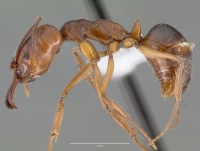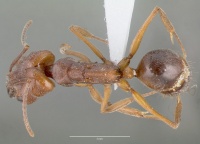Odontomachus clarus
| Odontomachus clarus | |
|---|---|

| |
| Scientific classification | |
| Kingdom: | Animalia |
| Phylum: | Arthropoda |
| Class: | Insecta |
| Order: | Hymenoptera |
| Family: | Formicidae |
| Subfamily: | Ponerinae |
| Tribe: | Ponerini |
| Genus: | Odontomachus |
| Species: | O. clarus |
| Binomial name | |
| Odontomachus clarus Roger, 1861 | |
| Synonyms | |
| |
Long thought to exist as two disjunct populations (Florida region in the SE and SW North America), recent findings of this species in Louisiana (Adams et al. 2010) suggests it may have a single contiguous range.
| At a Glance | • Polygynous |
Photo Gallery
Identification
Brown (1976) - A member of the Odontomachus haematodus group. Odontomachus clarus is like Odontomachus insularis, and it also shares with insularis the dark-colored male and 4, 3 palpal segmentation. In fact, the only reliable worker character I can find to separate the two is the different development of the acute apex of the petiolar node. In insularis, the node narrows fairly abruptly (in side view) to a long, thin, backcurved spine, which may occupy a quarter or more of the total height of the node. In O. clarus, the node as seen from the side tapers rapidly to a much shorter spine, which often is not really a spine at all, but simply a sharp conical apex. The shortest and most stumpy nodes tend to occur in small, pale yellowish-brown individuals from the northern limits of the species in Central Texas, and especially in the mountains of southeastern Arizona (Huachuca, Chiricahua and Santa Rita Mountains at altitudes of 1000- 1500 m., for example).
Identification Keys including this Taxon
Distribution
Southwestern North America from Arizona and New Mexico to southern Mexico and a disjunct occurrence in Florida.
Latitudinal Distribution Pattern
Latitudinal Range: 35.65355556° to 15.837197°.
| North Temperate |
North Subtropical |
Tropical | South Subtropical |
South Temperate |
- Source: AntMaps
Distribution based on Regional Taxon Lists
Nearctic Region: United States (type locality).
Neotropical Region: Mexico.
Distribution based on AntMaps
Distribution based on AntWeb specimens
Check data from AntWeb
Countries Occupied
| Number of countries occupied by this species based on AntWiki Regional Taxon Lists. In general, fewer countries occupied indicates a narrower range, while more countries indicates a more widespread species. |

|
Biology
Nests are often found under rocks or in grasses associated with both arid and mesic habitats. They have also been located under downed trees in fine sand and gravel soils (Smith 1939, Cokendolpher & Francke 1990, Deyrup and Cover 2004).
A nest found in San Angelo, Texas, during June 2020 by Andrew Graf, was polygynous with 7 dealate queens and about 200 workers. The colony was collected for observation and had 6 queens and 180 workers in August 2020. Two queens behave dominantly and exhibit physogastry at all times. The other queens perform more worker-associated tasks on average. Thus this species appears to follow the observed hierarchy of secondary polygyny seen in other Odontomachus species.
Regional Notes
Louisiana
Adams et al. (2010) - "On 11 August 2009 two head capsules were collected in the midden pile of a colony of Dorymyrmex flavus McCookon the road near the Corral Camp area of the Kisatchie National Forest in Central Louisiana (31°31.774’N 093°03.510’W Elev. 323’). The head capsules were missing the recognizable jaws but the converging dorsal furrows on the capsules matched the characters of Odontomachus (Deyrup et al. 1985, Brown 1976). Coloration and head size indicated a species other than the non-native Odontomachus haematodus (Linnaeus), already known to exist in southeastern Louisiana. Presence of the capsules within the midden pile indicate possible predation of Odontomachus by Dorymyrmex. Aggressive interaction between Dorymyrmex bureni (Trager) and O. brunneus has previously been reported by Wild (in Deyrup and Cover 2004). An Odontomachus colony was located on 26 March 2010 in the Kisatchie district of Kisatchie National Forest on the Long Leaf Vista trail (31°28.576’N 092°59.683’W Elev. 238’). Three workers were collected under a rock in sandy soil at the base of a rock bluff. Workers were hand collected and stored in ethanol. Another colony was located on 18 June 2010 near Corral Camp (31°32.105’N 093°03.403’W Elev. 270’) under a large rock next to a rotting stump near the road. The entire colony was collected, including workers and male and female alates. Vouchers are deposited in the Louisiana State Arthropod Museum."
New Mexico
Mackay and Mackay (2002) - Habitat. Semi-desert areas, especially in riparian areas. Biology. This ant nests under stones, and may be locally common, although they are rarely collected. Odontomachus clarus are fascinating predators which snap the elongated mandibles shut on prey. When placed in a vial, they can snap the mandibles together with such force they can flip completely out of the vial.
Cokendolpher and Francke (1990) - In Arizona we have found this species, usually in small numbers, under rocks and grass tussocks, in both dry and mesic sites. In western Texas it shows a preference for more mesic sites and fine soils; nests are usually found under rocks or logs.
Flight Period
| X | X | ||||||||||
| Jan | Feb | Mar | Apr | May | Jun | Jul | Aug | Sep | Oct | Nov | Dec |
Source: antkeeping.info.
- Check details at Worldwide Ant Nuptial Flights Data, AntNupTracker and AntKeeping.
 Explore: Show all Flight Month data or Search these data. See also a list of all data tables or learn how data is managed.
Explore: Show all Flight Month data or Search these data. See also a list of all data tables or learn how data is managed.
Life History Traits
- Queen number: secondarily polygynous (7 queens present, 2 physogastric, others show worker-like behaviours)
- Queen type: winged or dealate
- Male type: winged
- Worker caste: present
- Mean colony size: 200
Castes
Images from AntWeb
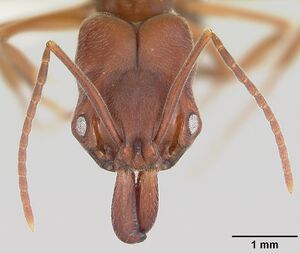  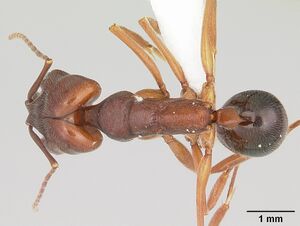 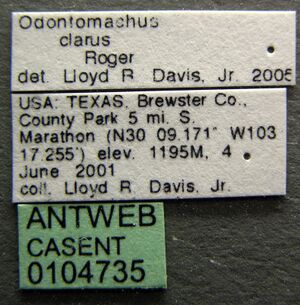
| |
| Worker. Specimen code casent0104735. Photographer April Nobile, uploaded by California Academy of Sciences. | Owned by CAS, San Francisco, CA, USA. |
Nomenclature
The following information is derived from Barry Bolton's Online Catalogue of the Ants of the World.
- clarus. Odontomachus clarus Roger, 1861a: 26 (w.) U.S.A. (Texas).
- Type-material: syntype workers (number not stated).
- Type-locality: U.S.A.: Texas (no collector’s name).
- Type-depository: MNHU.
- Patton, 1894: 618 (m.); Wheeler, W.M. 1908e: 407 (q.); Petralia & Vinson, 1980: 381 (l.).
- Subspecies of haematodus: Emery, 1911d: 115; Wheeler, W.M. 1914b: 40; Smith, M.R. 1939d: 129 (redescription); Creighton, 1950a: 55; Smith, M.R. 1951a: 787; Smith, M.R. 1958c: 112; Kempf, 1972a: 171.
- Status as species: Roger, 1863b: 22; Mayr, 1863: 436; Mayr, 1886d: 437; Cresson, 1887: 258; Emery, 1892d: 561 (in key); Dalla Torre, 1893: 49; Emery, 1895c: 269; Forel, 1901c: 124; Wheeler, W.M. 1908e: 407; Wheeler, W.M. 1910g: 562; Santschi, 1911d: 3; Cole, 1937a: 98; Taylor & Wilson, 1962: 142; Hunt & Snelling, 1975: 20; Brown, 1976a: 103, 136; Smith, D.R. 1979: 1344; Deyrup, Trager & Carlin, 1985: 191; Deyrup & Trager, 1986: 214; Deyrup, et al. 1989: 94; Brandão, 1991: 363; Bolton, 1995b: 295; Mackay & Mackay, 2002: 37; Deyrup & Cover, 2004b: 141 (in key); MacGown, et al. 2014: 529 (redescription).
- Senior synonym of clarionensis: Taylor & Wilson, 1962: 142; Brown, 1976a: 103; Smith, D.R. 1979: 1344; Brandão, 1991: 363; Bolton, 1995b: 295; MacGown, et al. 2014: 529.
- Senior synonym of coninodis: Brown, 1976a: 103; Bolton, 1995b: 295; MacGown, et al. 2014: 529.
- Senior synonym of texana: Wheeler, W.M. 1902f: 26; Wheeler, W.M. 1908e: 407; Emery, 1911d: 114; Creighton, 1950a: 55; Smith, M.R. 1951a: 787; Brown, 1976a: 103; Smith, D.R. 1979: 1344; Bolton, 1995b: 295; MacGown, et al. 2014: 529.
- Distribution: Mexico, U.S.A.
- clarionensis. Odontomachus haematoda subsp. clarionensis Wheeler, W.M. 1934f: 141 (w.) MEXICO (Revillagigedo Is).
- Type-material: 3 syntype workers.
- Type-locality: Mexico Revillagigedo Is, Clarion I., 26.iv.1925 (W.M. Wheeler).
- Type-depository: MCZC.
- Subspecies of haematodus: Wheeler, W.M. 1935g: 16; Kempf, 1972a: 171.
- Junior synonym of clarus: Taylor & Wilson, 1962: 142; Brown, 1976a: 103; Smith, D.R. 1979: 1344; Brandão, 1991: 363; Bolton, 1995b: 295; MacGown, et al. 2014: 529.
- coninodis. Odontomachus haematodus subsp. coninodis Wheeler, W.M. 1915b: 391 (w.q.) U.S.A. (Arizona).
- Type-material: 17 syntype workers, 2 syntype queens.
- Type-localities: 17 workers, 1 queen U.S.A.: Arizona, Huachuca Mts, Hunter and Miller Cañons, 5000-7000 ft, 12-14.xi. (W.M. Wheeler), 1 queen Arizona, Huachuca Mts, Ramsay Cañon, viii. (W.M. Mann).
- Type-depositories: LACM, MCZC.
- Subspecies of haematodus: Cole, 1937a: 98; Smith, M.R. 1939d: 128 (redescription); Creighton, 1950a: 55; Smith, M.R. 1951a: 787.
- Status as species: Smith, D.R. 1979: 1344.
- Junior synonym of clarus: Brown, 1976a: 103; Bolton, 1995b: 295; MacGown, et al. 2014: 529.
- texana. Odontomachus texana Buckley, 1867: 335 (w.) U.S.A. (Texas).
- Type-material: syntype workers (number not stated).
- Type-locality: U.S.A.: Northern Texas (S.B. Buckley).
- Type-depository: unknown; no material known to exist.
- Status as species: Cresson, 1887: 258; Dalla Torre, 1893: 52.
- Junior synonym of insularis: Emery, 1895c: 268.
- Junior synonym of clarus: Wheeler, W.M. 1902f: 26; Wheeler, W.M. 1908e: 407; Emery, 1911d: 114; Creighton, 1950a: 55; Smith, M.R. 1951a: 787; Brown, 1976a: 103; Smith, D.R. 1979: 1344; Bolton, 1995b: 297; MacGown, et al. 2014: 529.
Unless otherwise noted the text for the remainder of this section is reported from the publication that includes the original description.
Brown (1976) - In Odontomachus clarus, the node as seen from the side tapers rapidly to a much shorter spine, which often is not really a spine at all, but simply a sharp conical apex. The shortest and most stumpy nodes tend to occur in small, pale yellowish-brown individuals from the northern limits of the species in Central Texas, and especially in the mountains of southeastern Arizona (Huachuca, Chiricahua and Santa Rita Mountains at altitudes of 1000- 1500 m., for examples). The mountain samples have been considered as a separate subspecies coninodis, but I see no need to give a formal name to these depauperate ecotypes or ecophenotypes occurring at the upland range boundary of a variable species. Samples from nearby Tucson, taken at lower altitudes in the desert (types of subsp. desertorum) are large, richly colored, and similar to samples of O. clarus from much farther south in Mexico; I do not hesitate to call them conspecific without making further distinction. A transect of collections taken from the Sonoran desert flats up into the mountains should establish clines connecting the lowland and upland forms. Until this transect is properly established, there will of course remain some doubt as to whether the upland form might be a local species. The subspecies clarionensis is based on a worker from Clarion Island, far out in the Pacific of Mexico. This worker proves to be a rather typical specimen of O. clarus, as already indicated by Taylor and Wilson (1961) without comment.
Description
Worker
Rubidotestaceus, sparsissime pubcscens, nilidus, squama pedibusque pallidioribus, abdomine fusco, capite postice et in lateribus haud suiato, squama unispinosa. 8 Millim. long.
Eine haematodes sehr nahe stehende Art, aber kleiner und durch den an den Seiten und dem obern Drittel nicht gestreiften Kopf, sowie durch etwas andere Sculptur des Prothorax verschieden. — Der ganze Korper, mit Ausnahme des Hinterleibs, der schwarz oder schwarzbraun ist, ist hell rothlich gelb, die Beine und auch die Schuppe sind noch heller. Der Korper ist, aufser an den gestreiften Partien, die etwas matt erscheinen, glanzend und sehr sparlich mit anliegenden Harchen besetzt; langere abstehende Haare finden sich nur an den Mandibeln und der Unterseite und Spitze des Hinterleibs. Der Kopf ist langer als breit, hinten nicht verengt und etwas ausgerandet. Der Fuhlerschaft ist kaum so lang als der Kopf. Die Geifselglieder sind gedrungen. Die Mandibeln haben am Schneiderand, namentlich nach vorn, kleine Zahnchen und sind an der Spilze winklig gebogen, stumpf dreizahnig. Der Ranm zwischen den Fuhlergruben ist fein langs gestreift, der breite Hinterrand und die Seitenrander des Kopfs sind einzeln fein punktirt, aber gar nicht dicht und deshalb glansend. Alles Uebrige am Kopf wie bei haematodes. Der Prothorax ist quer koncentrisch gestreift; der ubrige Thorax zeigt feine Querstreifen. Die Schuppe ist konisch, allmalig zugespitzt und endet in einen nicht so scharfen und plotzlich zugespitzen Dorn, wie bei haematodes; unten sitzt ein denlicher Zahn. Das Abdomen hat eine abgestutzte, oben abgerundete Vorderseite, gelb gesaumte Spitzenrander an den einzelnen Segmenten und ist sehr glanzend und glatt. Das Uebrige wie bei haematodes.
Determination Clarifications
Records of clarus from the West Indies (Smith 1979) refer to some other species, perhaps Odontomachus ruginodis. All references to clarus in Florida (Deyrup et al. 1985; Deyrup 1989; Deyrup et al. 1989; Deyrup 1990; Sivinski et al. 1998) should be referred to Odontomachus relictus.
References
- Alatorre-Bracamontes, C.E., Vásquez-Bolaños, M. 2010. Lista comentada de las hormigas (Hymenoptera: Formicidae) del norte de México. Dugesiana 17(1): 9-36.
- B. J. Adams, X. Chen and L. M. Hooper-Bùi, "Odontomachus clarus Roger (Hymenoptera: Formicidae) reported in Kisatchie National Forest, Louisiana," [Midsouth Entomologist, vol. 3, no. pp. 104-105, 2010].
- Brown, W. L., Jr. 1976c. Contributions toward a reclassification of the Formicidae. Part VI. Ponerinae, tribe Ponerini, subtribe Odontomachiti. Section A. Introduction, subtribal characters. Genus Odontomachus. Stud. Entomol. 19: 67-171 (page 136, Revived status as species; page 103, Senior synonym of cominodis and desertorum)
- Deyrup, M.; Trager, J.; Carlin, N. 1985. The genus Odontomachus in the southeastern United States (Hymenoptera: Formicidae). Entomol. News 96: 188-195 (page 192, see also)
- Emery, C. 1911e. Hymenoptera. Fam. Formicidae. Subfam. Ponerinae. Genera Insectorum 118: 1-125 (page 115, subspecies of haematodus)
- MacGown, J.A., Boudinot, B., Deyrup, M. & Sorger, D.M. 2014. A review of the Nearctic Odontomachus (Hymenoptera: Formicidae: Ponerinae) with a treatment of the males. Zootaxa 3802(4): 515-552.
- Mackay, W.P. & Mackay, E.E. 2002. The Ants of New Mexico: 400 pp. Edwin Mellen Press, Lewiston, N.Y.
- Moura, M.N., Cardoso, D.C., Cristiano, M.P. 2020. The tight genome size of ants: diversity and evolution under ancestral state reconstruction and base composition. Zoological Journal of the Linnean Society, zlaa135 (doi:10.1093/zoolinnean/zlaa135).
- Patton, W. H. 1894. Habits of the leaping-ant of southern Georgia. Am. Nat. 28: 618-619 (page 618, male described)
- Petralia, R. S.; Vinson, S. B. 1980 [1979]. Comparative anatomy of the ventral region of ant larvae, and its relation to feeding behavior. Psyche (Camb.) 86: 375-394 (page 381, larva described)
- Roger, J. 1861a. Die Ponera-artigen Ameisen (Schluss). Berl. Entomol. Z. 5: 1-54 (page 26, worker described)
- Smith, M. R. 1939d. A study of the subspecies of Odontomachus haematoda (L.) of the United States (Hymenoptera: Formicidae). J. N. Y. Entomol. Soc. 47: 125-130 (page 129, subspecies of haematodus)
- Taylor, R. W.; Wilson, E. O. 1962 [1961]. Ants from three remote oceanic islands. Psyche (Camb.) 68: 137-144 (page 142, Revived status as species, senior synonym of clarionensis)
- Varela-Hernández, F., Medel-Zosayas, B., Martínez-Luque, E.O., Jones, R.W., De la Mora, A. 2020. Biodiversity in central Mexico: Assessment of ants in a convergent region. Southwestern Entomologist 454: 673-686.
- Wheeler, W. M. 1902g. A consideration of S. B. Buckley's "North American Formicidae.". Trans. Tex. Acad. Sci. 4: 17-31 (page 26, Senior synonym of texana)
- Wheeler, W. M. 1914c. Ants collected by W. M. Mann in the state of Hidalgo, Mexico. J. N. Y. Entomol. Soc. 22: 37-61 (page 40, subspecies of haematodus)
References based on Global Ant Biodiversity Informatics
- Alatorre-Bracamontes, C.E. and M Vasquez-Bolanos. 2010. Lista comentada de las hormigas (Hymenoptera: Formicidae) del norte de México. Dugesiana 17(1):9-36
- Brandao, C.R.F. 1991. Adendos ao catalogo abreviado das formigas da regiao neotropical (Hymenoptera: Formicidae). Rev. Bras. Entomol. 35: 319-412.
- Brown W. L., Jr. 1976. Contributions toward a reclassification of the Formicidae. Part VI. Ponerinae, tribe Ponerini, subtribe Odontomachiti. Section A. Introduction, subtribal characters. Genus Odontomachus. Stud. Entomol. 19: 67-171.
- Castano-Meneses, G., M. Vasquez-Bolanos, J. L. Navarrete-Heredia, G. A. Quiroz-Rocha, and I. Alcala-Martinez. 2015. Avances de Formicidae de Mexico. Universidad Nacional Autonoma de Mexico.
- Cokendolpher J. C., and O. F. Francke. 1990. The ants (Hymenoptera, Formicidae) of western Texas. Part II. Subfamilies Ecitoninae, Ponerinae, Pseudomyrmecinae, Dolichoderinae, and Formicinae. Special Publications, the Museum. Texas Tech University 30:1-76.
- Cokendolpher J.C., Reddell J.R., Taylor S.J, Krejca J.K., Suarez A.V. and Pekins C.E. 2009. Further ants (Hymenoptera: Formicidae) from caves of Texas [Hormigas (Hymenoptera: Formicdae) adicionales de cuevas de Texas]. Texas Memorial Museum Speleological Monographs, 7. Studies on the cave and endogean fauna of North America, V. Pp. 151-168
- Cover S. P., and R. A. Johnson. 20011. Checklist of Arizona Ants. Downloaded on January 7th at http://www.asu.edu/clas/sirgtools/AZants-2011%20updatev2.pdf
- Dattilo W. et al. 2019. MEXICO ANTS: incidence and abundance along the Nearctic-Neotropical interface. Ecology https://doi.org/10.1002/ecy.2944
- Deyrup M. and Cover S. 2004. A new species of Odontomachus ant (Hymenoptera: Formicidae) from inland ridges of Florida, with a key to Odontomachus of the United States. Florida Entomologist 87: 136-144
- Deyrup, M. and S. Cover. 2004. A new species of Odontomachus ant (Hymenoptera: Formicidae) from inland ridges of Florida, with a key to Odontomachus of the United States. Florida Entomologist 87(2):136-144
- Eastlake Chew A. and Chew R. M. 1980. Body size as a determinant of small-scale distributions of ants in evergreen woodland southeastern Arizona. Insectes Sociaux 27: 189-202
- Emery C. 1892. Voyage de M. Ch. Alluaud dans le territoire d'Assinie (Afrique occidentale) en juillet et août 1886. Formicides. Annales de la Société Entomologique de France 60: 553-574.
- Fernandes, P.R. XXXX. Los hormigas del suelo en Mexico: Diversidad, distribucion e importancia (Hymenoptera: Formicidae).
- Fernández F., and T. M. Arias-Penna. 2008. Las hormigas cazadoras en la región Neotropical. Pp. 3-39 in: Jiménez, E.; Fernández, F.; Arias, T.M.; Lozano-Zambrano, F. H. (eds.) 2008. Sistemática, biogeografía y conservación de las hormigas cazadoras de Colombia. Bogotá: Instituto de Investigación de Recursos Biológicos Alexander von Humboldt, xiv + 609 pp.
- Hernandez, F. Varela and G. Castano-Meneses. 2010. Checklist, Biological Notes and Distribution of Ants (Hymenoptera: Formicidae) from Barranca de Metztitlán Biosphere Reserve, Hidalgo, Mexico. Sociobiology 56(2):397-434
- Johnson R. Personnal Database. Accessed on February 5th 2014 at http://www.asu.edu/clas/sirgtools/resources.htm
- Kempf, W.W. 1972. Catalago abreviado das formigas da regiao Neotropical (Hym. Formicidae) Studia Entomologica 15(1-4).
- Klotz, J.H., J.R. Mangold, K.M. Vail, L.R. Davis Jr., R.S. Patterson. 1995. A survey of the urban pest ants (Hymenoptera: Formicidae) of Peninsular Florida. Florida Entomologist 78(1):109-118
- LeBrun E. G., R. M. Plowes, and L. E. Gilbert. 2015. Imported fire ants near the edge of their range: disturbance and moisture determine prevalence and impact of an invasive social insect. Journal of Animal Ecology,81: 884–895.
- Luna, P., Y. Penaloza-Arellanes, A. L. Castillo-Meza, J. H. Garcia-Chavez, and W. Dattilo. 2018. Beta diversity of ant-plant interactions over day-night periods and plant physiognomies in a semiarid environment. Journal of Arid Environments 156: 69-76.
- MacGown J. A., B. Boudinot, M. Deyrup, and D. M. Sorger. 2014. A review of the Nearctic Odontomachus (Hymenoptera: Formicidae: Ponerinae) with a treatment of the males. Zootaxa 3802(4): 515-552.
- MacGown J. A., T. L. Schiefer, and M. G. Branstetter. 2015. First record of the genus Leptanilloides (Hymenoptera: Formicidae: Dorylinae) from the United States. Zootaxa 4006 (2): 392–400.
- Mackay W. P. and Mackay, E. E. 2002. The ants of New Mexico (Hymenoptera: Formicidae). Lewiston, New York: Edwin Mellen Press, 400 pp.
- McDonald D. L., D. R. Hoffpauir, and J. L. Cook. 2016. Survey yields seven new Texas county records and documents further spread of Red Imported Fire Ant, Solenopsis invicta Buren. Southwestern Entomologist, 41(4): 913-920.
- Morrison, L.W. 2002. Long-Term Impacts of an Arthropod-Community Invasion by the Imported Fire Ant, Solenopsis invicta. Ecology 83(8):2337-2345
- O'Keefe S. T., J. L. Cook, T. Dudek, D. F. Wunneburger, M. D. Guzman, R. N. Coulson, and S. B. Vinson. 2000. The Distribution of Texas Ants. The Southwestern Entomologist 22: 1-92.
- Quiroz Robledo L. N., and J. E. Valenzuela Gonzalez. 1993. Contribucion al conocimiento de la mirmecofauna del estado de Hidalgo, Mexico (Hymenoptera: Formicidae). En: Villavicencio-Nieto (ed) Flora y Fauna del Estado de Hidalgo. Universidad Autónoma de Hidalgo. p. 340-393. ISBN 968-63 40-36-X
- Quiroz-Robledo, L.N. and J. Valenzuela-Gonzalez. 2007. Distribution of poneromorph ants (Hymenoptera: Formicidae) in the Mexican state of Morelos. Florida Entomologist 90(4):609-615
- Reddell J. R., and J. C. Cokendolpher. 2001. Ants (Hymenoptera: Formicidae) from caves of Belize, Mexico, and California and Texas (U.S.A.) Texas. Texas Memorial Museum Speleological Monographs 5: 129-154.
- Rios-Casanova, L., A. Valiente-Banuet, and V. Rico-Gray. (2004). Las hormigas del Valle de Tehuacan (Hymenoptera: Formicidae): una comparacion con otras zonas aridas de Mexico. Acta Zoologica Mexicana 20: 37-54.
- Ríos-Casanova, L., A. Valiente-Banuet and V. Rico-Gray. 2004. Las hormigas del Valle de Tehuacan (Hymenoptera: Formicidae): Una comparacion con otras zonas aridas de Mexico. Acta Zoologica Mexicana 20(1):37-54
- Serrano-Cardozo, V. H., J. A. Lemos-Espinal, and G. R. Smith. 2008. Comparative diet of three sympatric Sceloporus in the semiarid Zapotitlan Valley, Mexico. Revista Mexicana de Biodiversidad 79: 427-434.
- Smith M. R. 1936. A list of the ants of Texas. Journal of the New York Entomological Society 44: 155-170.
- Smith M. R. 1939. A study of the subspecies of Odontomachus haematoda (L.) of the United States (Hymenoptera: Formicidae). Journal of the New York Entomological Society 47: 125-130.
- Van Pelt, A. 1983. Ants of the Chisos Mountains, Texas (Hymenoptera: Formicidae) . Southwestern Naturalist 28:137-142.
- Varela-Hernandez, F., M. Rocha-Ortega, R. W. Jones, and W. P. Mackay. 2016. Insectos: Hormigas (Formicidae) del estado de Queretaro, Mexico. Pages 397-404 in W. Jones., and V. Serrano-Cardenas, editors. Historia Natural de Queretaro. Universidad Autonoma de Queretaro, Mexico.
- Varela-Hernandez, F., M. Rocha-Ortega, W. P. Mackay, and R. W. Jones. 2016. Lista preliminar de las hormigas (Hymenoptera: Formicidae) del estado de Queretaro, Mexico. Pages 429-435 in . W. Jones., and V. Serrano-Cardenas, editors. Historia Natural de Queretaro. Universidad Autonoma de Queretaro, Mexico.
- Vasquez Bolanos M., and J. Escoto Rocha. 2018. Ants (Hymenoptera: Formicidae) of Aguascalientes. Investigacion y Ciencia 24(68): 36-40.
- Vasquez-Bolanos M. 2011. Checklist of the ants (Hymenoptera: Formicidae) from Mexico. Dugesiana 18(1): 95-133.
- Vásquez-Bolaños M. 2011. Lista de especies de hormigas (Hymenoptera: Formicidae) para México. Dugesiana 18: 95-133
- Wheeler W. M. 1908. The ants of Texas, New Mexico and Arizona. (Part I.). Bulletin of the American Museum of Natural History 24: 399-485.
- Wheeler W. M. 1915. Some additions to the North American ant-fauna. Bull. Am. Mus. Nat. Hist. 34: 389-421.
- Wheeler, G.C. and J. Wheeler. 1985. A checklist of Texas ants. Prairie Naturalist 17:49-64.
- Wheeler, William Morton. 1934. Ants From The Islands Off The West Coast Of Lower California and Mexico. The Pan-Pacific Entomologist. 10(3):131-144.
